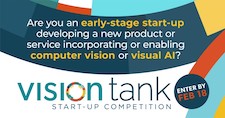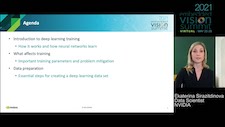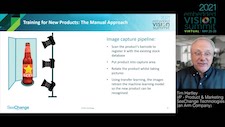| LETTER FROM THE EDITOR |
Dear Colleague,
Do you work at an early-stage start-up company developing a new product or service incorporating or enabling computer vision or visual AI? Do you want to raise awareness of your company and products with potential customers, investors and partners? Enter the seventh annual Vision Tank Start-Up Competition, offering start-up companies recognition and rewards, including the opportunity to present their new products or product ideas to more than 1,000 influencers and product creators at the Embedded Vision Summit, the key event for system and application developers who are incorporating computer vision and visual AI into products. Best of all, entry is free! For more information on the Vision Tank Start-Up Competition and to enter, please see the program page. Applications are due by March 1. Registration for the Embedded Vision Summit, taking place May 17-19 in Santa Clara, California, is also now open, and if you register by March 11, you can save 25% by using the code SUMMIT22-NL. On Thursday, March 17 at 9 am PT, Network Optix will deliver the free webinar “A Platform Approach to Developing Intelligent Video Products” in partnership with the Edge AI and Vision Alliance. IP cameras — traditionally used in surveillance applications — have become a mainstay in a variety of applications to visually (and often also audibly) monitor people, facilities, and other objects and environments. When combined with AI-enabled computer vision applications, these diminutive devices — together with USB webcams, wearable cameras, and production monitoring cameras — become data-gathering behemoths, enabling an entire universe of new Google-for-the-real-world applications driven primarily by video. With the density of data now able to be captured by video cameras — faces, people, objects, vehicles, and more — companies are recognizing the value of emerging edge and AI technologies that focus on capturing, analyzing, streaming, and delivering high definition video and its related metadata. But developing full-featured, full-stack solutions that can automatically recognize and manage devices, can accommodate an existing tech infrastructure, and can scale to any size for any set of customer personas is a difficult task. Network Optix believes it has developed a platform that can alleviate the pain of developing intelligent video products and that is malleable enough to be used for any potential downstream intelligent video-enabled application — Nx Meta. This webinar will explore Network Optix’ Nx Meta intelligent video platform and explain how you can rapidly develop a full-stack (cloud, desktop, mobile, and server), AI-enabled, edge-ready, enterprise video product in a matter of weeks. You’ll learn how easy it is to deploy rich new visual intelligence products at global scale by choosing a platform that scales effortlessly with you. Presented by Nathan Wheeler, Chairman and CEO of Network Optix, it will begin with an introduction to the company and some of the ‘Powered by Nx’ products currently in use around the world. Wheeler will also discuss numerous examples of vertically aligned and industry-specific computer vision product use cases. For more information and to register, please see the event page. Brian Dipert |
| DEEP LEARNING MODEL TRAINING |
|
Getting Started with Vision AI Model Training Automated Neural Network Model Training: The Impact on Deploying and Scaling ML at the Edge |
| EXPERT INSIGHTS |
|
Can You Make Production ML Work Without Dozens of PhDs? Performance, Ease of Development or Features: What Do Inferencing Software Developers Need Most? |
| UPCOMING INDUSTRY EVENTS |
|
Developing Optimized Systems with BrainChip’s Akida Neuromorphic Processor – BrainChip Webinar: February 24, 2022, 9:00 am PT A Platform Approach to Developing Intelligent Video Products – Network Optix Webinar: March 17, 2022, 9:00 am PT Embedded Vision Summit: May 17-19, 2022, Santa Clara, California |
| FEATURED NEWS |
|
Teledyne FLIR launches Conservator Subscription Software to Accelerate AI Development with Thermal Imaging Real-time Video Enhancement Reaches New Standard with Visionary.ai and Inuitive Partnership Upcoming Online Training from FRAMOS Explores CMOS Camera Characterization Lattice Semiconductor FPGAs Power Next-generation Lenovo Edge/AI Experiences ADLINK Technology Launches COM-HPC Client Type and COM Express Type 6 Modules with 12th Generation Intel Core Processors |






